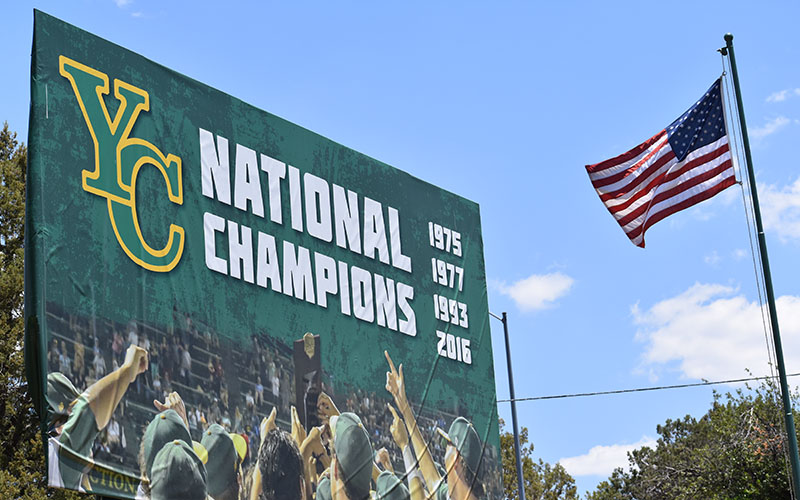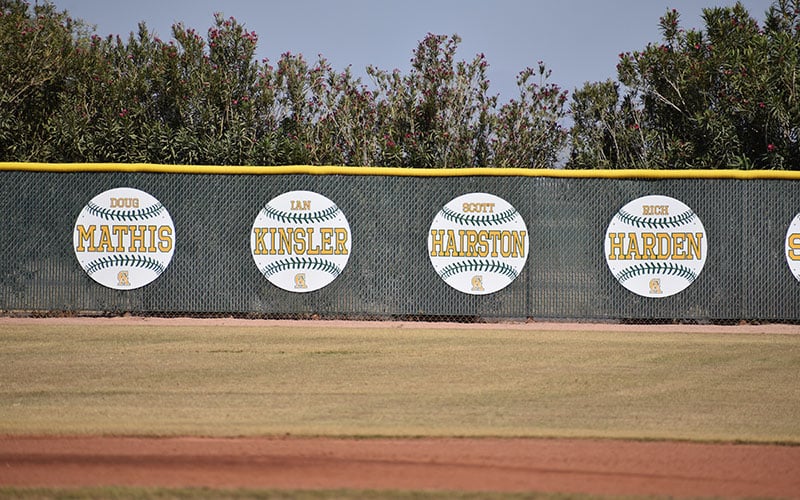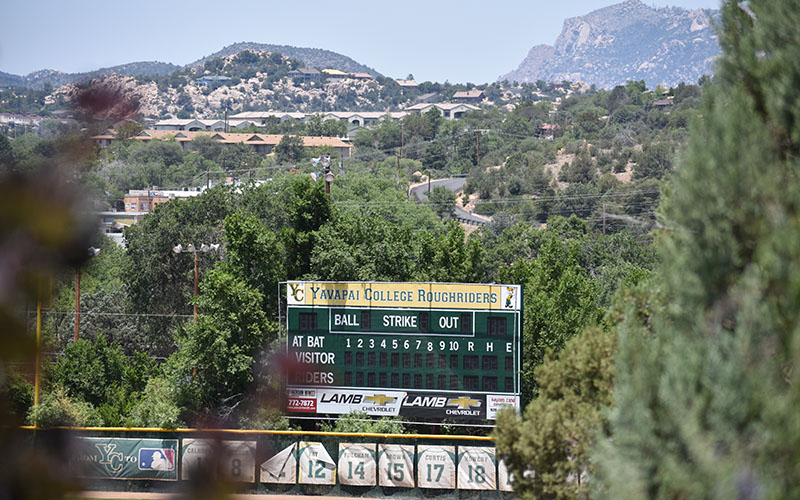PHOENIX — When assessing the Major League Baseball talent pool that originates in Arizona, two colleges tend to come to mind: Arizona State University and the University of Arizona. The rival schools have sent nearly 800 players to the professional level throughout the history of their storied programs.
From a lesser perspective, some of the country’s most talented baseball players have discovered their own path to the major league level.
The junior college route.
Across the United States, junior colleges are providing major league hopefuls with a less traditional, yet highly regarded path to the big leagues. Home to a hotbed of athletic talent and optimal weather year-round, JUCO baseball programs in Arizona have created their own measure of prominence.
“If it weren’t for Coach Dangler and Yavapai, there’s no chance I’d have made it to the big leagues,” six-time All-Star pitcher Curt Schilling said Friday in a text message about former Roughriders coach Dave Dangler.
Central Arizona College coach Anthony Gilich calls Arizona “an all-around mecca for baseball.”
Gilich knows. He leads a program with a proud tradition of success. Between players who have committed to Central Arizona and those who played for the team this past season, the Vaqueros had six players selected in this year’s MLB draft.
A member of the Arizona Community College Athletic Conference (ACCAC), the Coolidge school competes against 13 others in one of the more revered JUCO conferences in the nation. Eleven of the 14 teams finished this past season with a .500 record or better and three of the schools — Central Arizona, Mesa Community College, and Yavapai College — have combined to win 10 national championships.
Although comparing the talent level of a junior college program to one at the Division I level is much like comparing apples to oranges, the history of the ACCAC is certainly not short of draft picks.
Central Arizona, Mesa, and Yavapai have combined to send over 400 players through the draft. Some have gone on to play at four-year schools before being drafted while others have been directly drafted from JUCO programs.
Of those players, 55 have gone on to major league careers. Renowned names include Mike Devereaux (Mesa CC), Curt Schilling (Yavapai), Ian Kinsler (CAC), Rich Harden (CAC) and Kole Calhoun (Yavapai).
When choosing to attend a JUCO program, players weigh a number of reasons when making their final decision. One of them appears to be more obvious than others.
“A lot of times, good players and good students will turn the opportunity at the four-year level down to come to junior college because they want to continue to be draft eligible every single year,” Gilich said. “That door is open in baseball much more than other sports and that’s one of the leading reasons why players end up pursuing junior college.”
At four-year schools, the MLB rule outlines that players can not be made draft eligible until they’ve completed their junior year or are at least 21-years-old.
This allows for a quicker and often more effective route to professional baseball for players at the JUCO level. Not to mention, it also allows players the opportunity to see immediate playing time whereas those at a four-year school may be forced to beat out a 22-year-old fifth-year senior as a freshman or sophomore.
“They’re competing against guys their own age,” Gilich said. “It makes it a little easier to get on the field and contribute right away.”
Similar to other collegiate sports, players may choose a junior college because they feel they aren’t academically sound enough to succeed and stay on the field at the Division I level. JUCO programs allow students to grow into their academic careers while also working to develop their abilities on the playing field.
“That year away from home was beyond invaluable for me,” said Schilling, who attended Shadow Mountain High School and went on to an accomplished major league career that included stops with the Arizona Diamondbacks and Boston Red Sox.
Another factor that weighs on the mind of players as they’re completing their high school careers is maturity.
“There are a few exceptions of guys who play right away at the Division I level but I was not one of those guys,” Kody Funderburk said. “I knew that I needed the extra two years to grow not only physically but mentally as well.”
Funderburk is an Arizona native and has committed to play next season for Dallas Baptist, a Division I school in the Missouri Valley Conference. He just recently completed his second year at Mesa Community College as an infielder and left-handed pitcher for the Thunderbirds.
He credits his time at Mesa Community College for allowing him to grow into the player he has become now, rather than attending a Division I school right out of high school and being forced to either redshirt or see little to no playing time.
“If you want immediate playing time, you’re going to have to go to a JUCO program,” he said. “I’ve had a number of teammates who went to Division I programs directly out of high school and ended up coming back for a year because they either had to redshirt or wanted a year away from the game.”
The two-year outlook shines a light on junior college programs in a way that sets them apart from Division I programs. It also provides many players with an optimistic view of where they hope to eventually be. For Funderburk, he knew from the start that he would be at Mesa for two years and that if he simply put his head down and worked, he would move on to something better.
Along with the warm weather appeal in Arizona and the history of success in the ACCAC is the factor of proximity.
“A lot of Four Corner scouts are located in the Phoenix area as well as on the west coast,” said Ryan Cougill of the region that includes Arizona, Utah, New Mexico and Colorado. “It’s accommodating for scouts and helps players immensely with exposure.”
Cougill is a fifth-year head coach for the reigning national champions at Yavapai College in Prescott. He leads a program with a very rich tradition, helping to develop players and set them on a path to the majors.
In 2015 and 2016, Cougill’s program produced the highest number of draft picks taken out of the ACCAC. His view of JUCO baseball tells a more genuine tale of what sets it apart from the Division I level.
“From a coaching perspective, you get to spend a lot of one-on-one quality time with players at the junior college level,” Cougill said. “There’s a lot of years where you’re like, ‘Man, I wish I had more time with those guys and could be a part of their lives for two more years.’ ”
An often reality at the junior college level is that players will reach the peak of their development at around the same time they’re headed off to a four-year school or to professional baseball after being drafted.
Not to be dismissed, JUCO programs also have their disadvantages. In some cases, Division I players with eligibility may return to the junior college level looking for playing time. This can impede on freshmen or sophomores who are simply working to develop their skills.
Whether it’s two years at the JUCO level or straight to a four-year school, players want to go to a program that best fits them and their needs. Cougill has a simple message for those who do ultimately decide to pursue the route of JUCO baseball.
It’s the type of message that has attracted decades of talent to the ACCAC and programs like Yavapai and will continue to do so.
“Kids really love baseball when they’re either playing or serving a valuable role,” he said.
“Each kid is unique but I think when you encompass all of them, it’s one of those few things that allows there to be a number of reasons for why guys come (here) to play.”



